One of my favorite things to include in any bouquet is some kind of edible ingredient, and the more recognizable the better.
Over the years I’ve tucked carrots into a famous chef’s bridal bouquet, included chili peppers and tiny eggplant in food-loving grooms’ boutonnieres, sprinkled clusters of cherry tomatoes through hundreds of centerpieces, added raspberries to guestbook displays, and woven scented herbs into as many floral designs as I could manage.
 There’s nothing quite like pairing food with flowers. Most people don’t pay much attention to what’s in a vase unless they recognize the ingredients, and a little food is usually all it takes to get people talking.
There’s nothing quite like pairing food with flowers. Most people don’t pay much attention to what’s in a vase unless they recognize the ingredients, and a little food is usually all it takes to get people talking.
As you’re planning your garden this year, I highly encourage you to add some edibles alongside your cut flowers. Not only are they beautiful for arrangements, they are wonderful for eating.
All these varieties are easy to grow from seed. Many love the heat and produce abundantly from summer through the first fall frost. Because our farm is situated in an area with relatively cool summers, I grow most of my edibles in a hoophouse for an added level of heat. But if your garden gets plenty of sun, you can grow all your edibles outdoors.
Here are some of my favorite edibles for floral design.
 Peas
Peas
You can start peas now to enjoy this spring, planting seeds directly in the garden. Fresh peas or young whole pods are delicious added fresh to salads, rice dishes, and stir-fry, or used in soups.
Peas are a cool weather crop. Direct seed in early spring as soon as the soil can be worked. Provide a strong trellis or support for vines to climb.
We stock two unusual heirlooms. Their vining stems make a wonderful, unexpected addition to summer flower arrangements and are a real conversation starter. Blue Podded Blauwschokkers produce vines loaded with the most striking dark purple pea pods for shelling. Pick early for best flavor. The color mixes beautifully with cool-toned florals. Golden Sweet churns out loads of delicious chartreuse-yellow snow pea pods.
For use in floral design, harvest stems when pods are brightly colored, taking care when handling delicate vines. Expect a vase life of 5 to 7 days. (Please note that unlike these edible garden peas, the seeds of sweet peas are poisonous if ingested; it’s important to make this distinction in the garden.)
 Tomatoes
Tomatoes
If you could grow only one thing in your vegetable garden, chances are you’d choose tomatoes—the longtime favorite for salads, sauces, and fresh eating. And tomatoes are probably my all-time favorite vegetables to sneak into bouquets, too. They look amazing tumbling over the edge of any size arrangement.
I especially love the smaller-fruited types since they are the easiest to incorporate. For larger arrangements, medium-sized fruits are perfect.
 Start seed indoors in trays 8 to 10 weeks before last frost; transplant out after all danger of frost has passed. Tomatoes like heat and thrive in a hoophouse or tunnel.
Start seed indoors in trays 8 to 10 weeks before last frost; transplant out after all danger of frost has passed. Tomatoes like heat and thrive in a hoophouse or tunnel.
Two of my favorites are ‘Currant Red’, a sweet variety producing an abundance of long stems loaded with tiny fruit all summer and into autumn, and ‘Chocolate Cherry’, which has unique, versatile coloring—the medium-sized fruit changes from striped green to hot chocolate-brown with green streaking.
For design work, I also love ‘Indigo Rose’—one of the most eye-catching tomatoes we’ve grown. It boasts 8- to 10-inch-long (20-25 cm) stems loaded with glossy black fruit with green undersides. It’s gorgeous in the garden and in arrangements, though not the best for eating. Fruit holds very well on the stem.
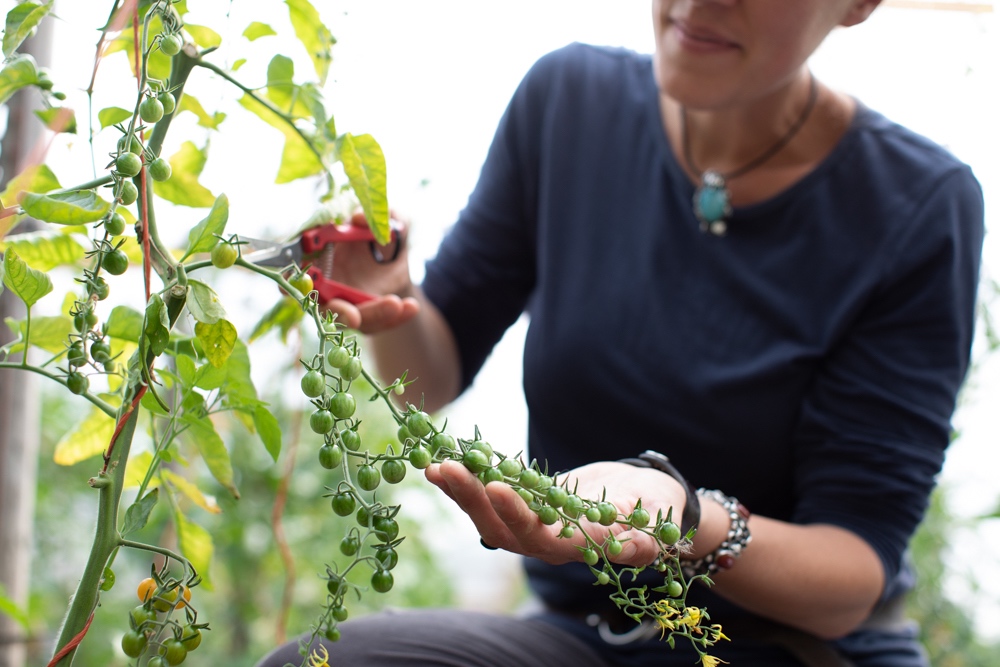 Harvest tomatoes for floral arrangements after all of the fruit has developed on a cluster, but before they completely develop their mature color and begin to loosen from their stems. Remove most of the leaves since they will wilt. Fruit will persist 4 to 5 days.
Harvest tomatoes for floral arrangements after all of the fruit has developed on a cluster, but before they completely develop their mature color and begin to loosen from their stems. Remove most of the leaves since they will wilt. Fruit will persist 4 to 5 days.
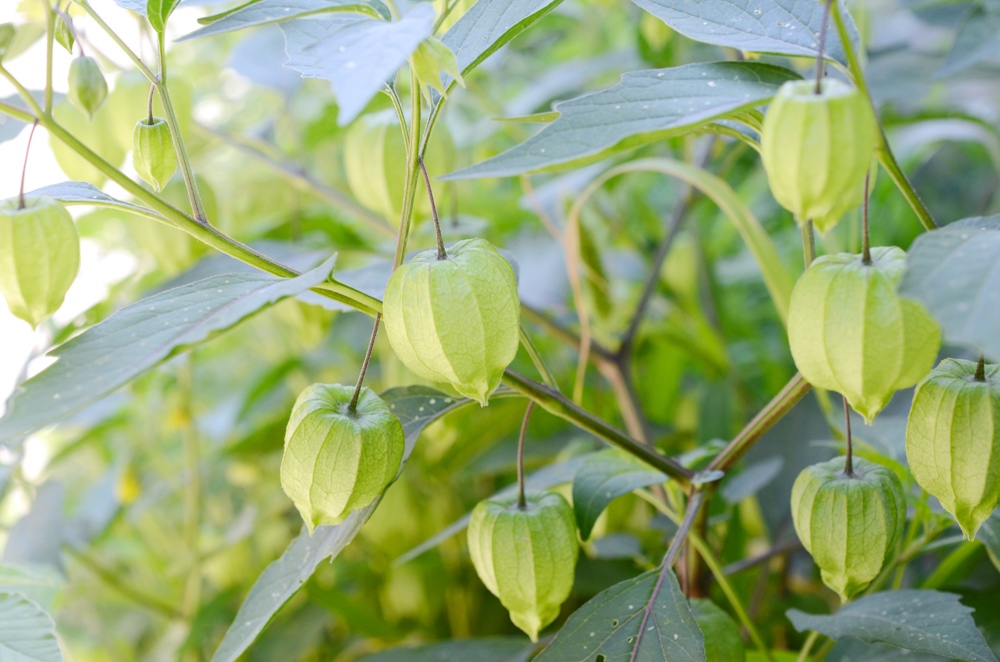 Tomatillos
Tomatillos
This easy-to-grow, heat-loving edible is an extremely productive addition to the garden. The fruits can be used to make salsa and tangy green sauce, fresh or cooked. For kitchen use, harvest when fruit has filled the husk and the husk begins to split.
Start seed indoors in trays 4 to 6 weeks before last frost; transplant out after all danger of frost has passed and soil is thoroughly warmed. A trellis or tomato cage will help contain plants.
Tomatillo ‘Verde’ is an easy-to-grow heat lover and an extremely productive addition to the garden. After buttercup-yellow flowers bloom and set fruit, graceful stems throw beautiful lantern-like pods that makes surprising additions to arrangements.
For design use, harvest once seed pods have formed. Expect a vase life of 7 days.
 Herbs
Herbs
Herbs add texture and scent to arrangements in a way nothing else does, but their first use is in the kitchen. Here are four of my top picks.
Basil is the ultimate dual-purpose plant: one of the most fragrant, easy-to-grow, and abundant summer foliage plants. Nearly everyone loves basil, the basic ingredient in pesto. But there are many varieties with surprising flavors and spicy hints that lend themselves to use in baking, roasting, and grilling.
Start seed indoors in trays 6 weeks before last frost, and be sure to wait to transplant out until after all danger of frost has passed and the weather has warmed. Basil is very sensitive to cold.
For kitchen use, harvest tender leaves, but for design, wait to harvest until stems begin to toughen and firm, or as soon as flowers begin to form.
Cut foliage is prone to wilting in the heat, so harvest during the coolest part of the day and place directly into water to rest a few hours before arranging. Stems will last 7 to 10 days, often rooting in the vase.

‘Aromatto’ is a handsome variety that features tall, deep purple stems, glossy bicolor plum-veined leaves, and brilliant amethyst flower spikes. The aromatic foliage is a spicy combination of licorice and mint. Your summer and fall bouquets will never be the same with this growing in the garden.
The unforgettable scent of ‘Cinnamon’, a long-time favorite of mine, makes it a wonderful addition to summer bouquets. This lovely variety features dark purple flowers atop green leaves and chocolate-colored stems.

Dill is a kitchen garden favorite for pickling and canning. Any combination of fresh garden vegetables, marinated in the refrigerator for a few hours in vinegar with dill foliage and florets, makes a wonderful summer side dish.
Start dill seed indoors in trays 4 weeks before last frost; gently transplant out after all danger of frost has passed. Dill can also be direct seeded into the garden after danger of frost. Provide support so stems don’t topple. For an extended harvest, sow two to three successions.
‘Bouquet’ is an early-maturing dill variety that produces tall stems loaded with large chartreuse umbels. This plant is super versatile and makes a wonderful addition to summer bouquets. It’s fragrant and easy to grow.
For bouquets, harvest when umbels are fully open and bright yellow-green, and remove some of the fernlike foliage near the base of the stem. Expect a vase life of 10 days.

Oregano
True Greek oregano is one of the most hardworking perennial plants we grow each summer. Dried oregano is a favorite seasoning for pizza, tomato sauce, and other Mediterranean dishes. To dry, harvest stems just before flowering and hang them in bunches in paper bags in a warm, dry environment. Or harvest fresh leaves for a delicious addition to salads, pasta, rice dishes, soups, and sauces.
Start seed indoors in trays 8 to 10 weeks before last frost. Seed requires light to germinate so do not cover. Bottom water until seedlings emerge. Transplant out after all danger of frost has passed.
Glowing green stems are topped with fragrant, airy white blossoms that leave behind fluffy green seed heads that make an amazing addition to any arrangement. Greek oregano is a must-grow for market bouquets. The fragrant flowers are also well-loved by pollinators. If seed is sown early enough, this perennial will flower the first year from seed.
For design, harvest at any stage, whether in flower or when seed heads have formed. Expect a vase life of 7 to 10 days.
 Orach
Orach
I discovered this fantastic plant in a friend’s veggie patch some years back and have been a huge fan ever since. The young leaves are edible and are often compared to spinach. If plants are left to grow, you’ll be rewarded with gorgeous seedy stems that are wonderful in large, mid-summer arrangements.
Start seed indoors in trays 4 to 6 weeks before last frost; transplant out after all danger of frost has passed.
Caramel Apple Mix includes brilliant Granny Smith green and rich chocolaty crimson. ‘Ruby Gold’ was shared with us by Frank Morton at Wild Garden Seed. Its eye-catching foliage is a glowing acid-green, and stalks are streaked with cranberry. Seeds are a blend of dusty rose and sun-bleached moss.
Fresh stems harvested early in the season for design work last longest when you dip them for 7 to 10 seconds in boiling water directly after harvest; seeded stems do not need any special post-harvest treatment. Orach can last up to 2 weeks in the vase.

Shiso, or perilla, is in the mint family, with a flavor similar to basil, and often used in Asian dishes. It’s a great fresh addition to salads, fish, pasta, and rice dishes.
Freeze seed for 2 to 3 weeks before sowing to speed up germination. Sow indoors 4 weeks before last frost. Sow seeds shallowly or cover lightly, as light is required for germination.
‘Purple Frills’ has striking, deep chocolaty-maroon foliage that provides exceptional textural interest to arrangements. Leaves are crimped and curled with serrated edges.
This superb scented foliage is a great choice for floral design from mid-summer through autumn. Harvest when foliage has become thick and stems are woody, or any time after a flower spike begins to emerge. Expect a vase life of 10 to 14 days with preservative.
 Edible flowers
Edible flowers
You might be surprised by the number of edible flowers you can grow. These make beautiful garnishes and add earthy, nutty, unusual flavors and great texture to salads and other dishes. Here are some of my favorites.
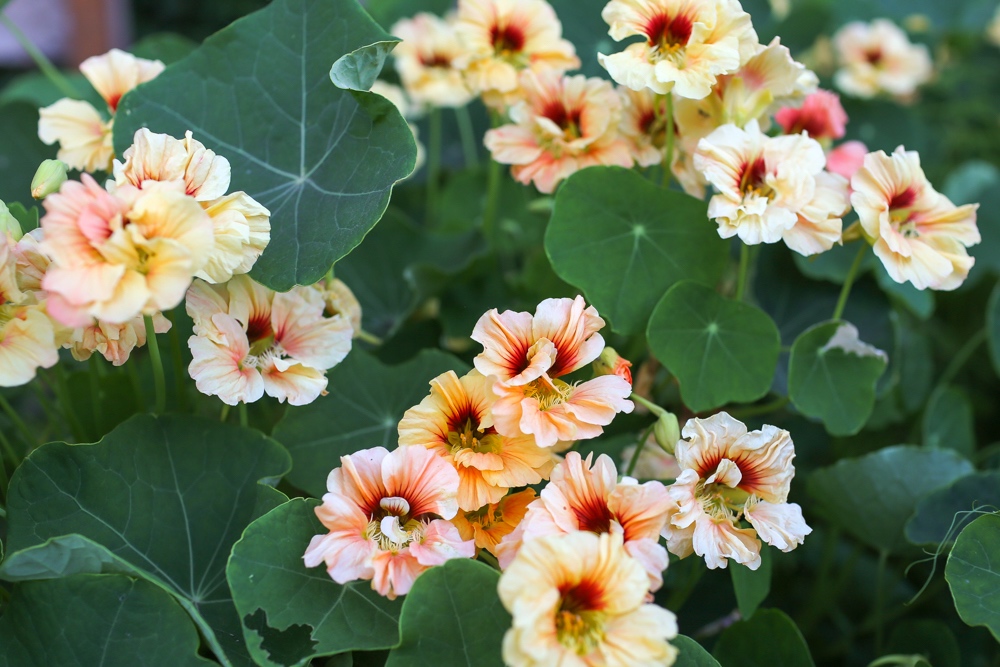 Nasturtiums
Nasturtiums
Nasturtium flowers have a wonderful peppery flavor and make a incredibly beautiful and delicious addition to salads. They also can be used to decorate cakes (and cupcakes). For kitchen use, cut flowers in the cool morning or evening just before use. They can be stored for a few hours in plastic bags in the refrigerator.
Start seed indoors in pots 4 to 6 weeks before last frost; transplant out after all danger of frost has passed. Nasturtiums are very sensitive to cold; wait until weather has warmed to transplant outside.
Provide a strong trellis or support for the rambling vines, which are covered with blooms that are lovely in bouquets. The foliage lasts an extremely long time in the vase, adding interest and movement to large-scale arrangements.
After years of hunting for a great trailing variety of nasturtium in peach and pastel color palettes, I finally discovered the elusive ‘Gleam Salmon’. This vine is loaded with a profusion of creamy, salmony-peach blossoms all summer long.
For the longest vase life, harvest flowers just as they are opening. If using the foliage, pick individual leaves or full vines once they become leathery or firm to the touch. Both flowers and foliage will persist 7 to 10 days in the vase, even longer if preservative is used.
 Bachelor’s Buttons
Bachelor’s Buttons
This cutting garden classic is easy to grow, pollinator-friendly, and a great choice for beginners. Plants will flower over a long period of time if regularly harvested. Add the bright, colorful petals to salads or egg dishes as a delightful garnish.
Bachelor’s Buttons are cold-tolerant; plants dislike being transplanted, so direct seed into the garden in fall or early spring. For an extended harvest, sow two plantings, one month apart. Harvest individual flowers when buds are about halfway open, or harvest large branching stems when most of the buds in the spray are colored. Expect a vase life of 7 days.
Two special mixes are ‘Classic Fantastic’, which combines shades of ethereal sapphire, pale blue, and cool-hued bicolors to resemble the midnight sky, and ‘Classic Romantic’, the sweetest mix of blush, pink, white, and bicolors for romantic bouquets and wedding work.

Calendulas
Mix calendula petals into egg dishes, including quiche and frittatas, or add them fresh to salads. Whole florets can be frozen into ice cubes to add color to summer drinks. You also can dry petals in a well-ventilated area away from sunlight to save in jars for winter use.
Start seed indoors in trays 4 to 6 weeks before last frost; transplant out after all danger of frost has passed. Or direct sow and succession plant every 2 to 3 weeks to stagger the harvest.
To use calendulas in bouquets, pick when flowers are halfway open. With flower food, expect a vase life of 6 to 7 days. Foliage is sticky, so wear gloves when harvesting.
‘Ivory Princess’, a tall showstopper with giant flowers, is a new favorite of mine. Petals are a mix of creamy buff-yellow, the color of baby duckling down. The serrated tips have the tiniest outline of brown, giving a ruffled, lacy effect that beautifully complements the dark brown eye. This unreal beauty is great for bouquets and wedding work.
‘Zeolights’ is a garden standout with a dark reddish-brown eye and apricot-peach petals that have a rusty reverse side. These abundant bloomers have tall, strong stems and are a fantastic addition to market bouquets and large arrangements. The warm peachy flowers look as if they are glowing in the vase.

Marigolds
If you haven’t already enjoyed salads with marigold petals, you’re in for a surprising treat. Marigolds have been used as a stand-in for saffron, and they make a colorful addition to omelets, rice, and soups.
We offer two miniature-flowered varieties that reach over 30 inches (76 cm) and are loaded with dozens of penny-sized glowing blooms.
‘Tangerine Gem’ has tangerine blooms with darker orange centers, and Starfire Mix has shades of red, orange, and gold, with numerous color variations and bicolors. The ferny foliage is wilt-resistant and scented, making these varieties a summer bouquet staple.
Start seed indoors in trays 4 to 6 weeks before last frost; transplant out after all danger of frost has passed. Marigolds can also be direct seeded once weather has warmed.
Harvest for bouquets when one-third to one-half of the flowers on a spray are open. Stems will last 7 to 10 days in the vase.

Pansies
Every generation loves pansies. A generous sprinkling of fresh petals and flowers add color and delight to salads or any dish. If you’re ambitious, you can learn to make candied pansy flowers for exquisite cake garnishes—or just use fresh florets as decoration.
Pansies can actually grow tall enough to be used as cut flowers; we regularly harvest stems that are 8 to 12 inches (20 to 30.5 cm) long, with some even stretching to 15 inches (38 cm).
It’s best to start pansy seed indoors in trays 10 to 12 weeks before last frost. Seeds require darkness to germinate, so lightly cover.
Pansies can withstand light frost, so cold-climate gardeners can pick a transplant date that is about 2 weeks before the last frost date.
 For floral arrangements, pick when flowers are starting to open. The flowers last an unbelievably long time in the vase; as the lower flowers on the stem begin to fade, new ones appear. We’ve had pansies look beautiful for well over a week in just plain water and more than 10 days when we used flower food. Here are a few of my favorite varieties.
For floral arrangements, pick when flowers are starting to open. The flowers last an unbelievably long time in the vase; as the lower flowers on the stem begin to fade, new ones appear. We’ve had pansies look beautiful for well over a week in just plain water and more than 10 days when we used flower food. Here are a few of my favorite varieties.
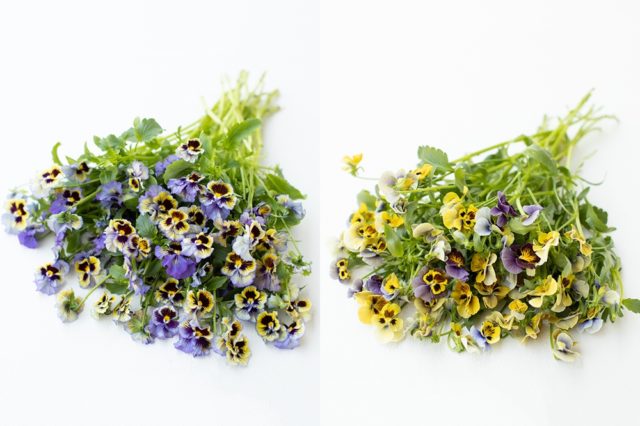 ‘Frizzle Sizzle Yellow Blue Swirl’ (pictured left) has blooms that darken as they age and are a gorgeous mix of smokey lavender-blue and gold with chocolate faces. This is one of the most uniquely colored pansies we’ve ever seen!
‘Frizzle Sizzle Yellow Blue Swirl’ (pictured left) has blooms that darken as they age and are a gorgeous mix of smokey lavender-blue and gold with chocolate faces. This is one of the most uniquely colored pansies we’ve ever seen!
The flowers of ‘Envy’ (pictured right), a highly unusual novelty, range from chocolate hues to metallic lavender to yellow with a green cast. Strongly scented blooms have a sepia-toned wash and look stunning planted en masse. Outward facing flowers are beautifully placed along stems, giving a lovely show without smothering plants.

Rococo Frill Mix (pictured left), a rich combination of yellow, velvet-purple, lavender, and maroon petals, are eye-catching with their prominent veining. Petals are ruffled and edged with a lighter pigmentation, making them look like lace. These medium-size flowers carry a light fragrance and are held on some of the strongest stems we’ve seen in the pansies we’ve tested.
Aalsmeer King Size Mix (pictured right), an eye-catching combination of gold, cranberry, lavender, and bicolor flowers, is similar in coloring to Rococo Mix. The distinct faces on each flower look like butterflies and lend so much personality to vase arrangements.
 Lovely in either pots or the landscape, Viola ‘Gem Pink Antique’ looks spectacular when planted en masse. Flowers open to display beautiful violet-purple petals that fade to an iridescent mauve. The most mature blooms have hints of turquoise—there is so much variation in one planting! Left to grow, flowers make the sweetest cuts for tiny bouquets and have a good, upright growth habit.
Lovely in either pots or the landscape, Viola ‘Gem Pink Antique’ looks spectacular when planted en masse. Flowers open to display beautiful violet-purple petals that fade to an iridescent mauve. The most mature blooms have hints of turquoise—there is so much variation in one planting! Left to grow, flowers make the sweetest cuts for tiny bouquets and have a good, upright growth habit.

Ornamental squash
When Chris and I bought our house, one of the first things I planted in the garden was a row of winter squash, and every year I add new favorites to my already overflowing list. In addition to making beautiful ornaments, many make for fine eating.
Unlike other garden plants that are grown tightly together in closely spaced rows, squash do best planted some distance apart in hills. Be sure to give these rambling vines enough room to spread out. I space rows 6 feet (2 m) apart and give each plant 3 feet (1 m) on each side. Squash dislike having their roots disturbed and do best when direct sown. Plant seeds after all danger of frost has passed.
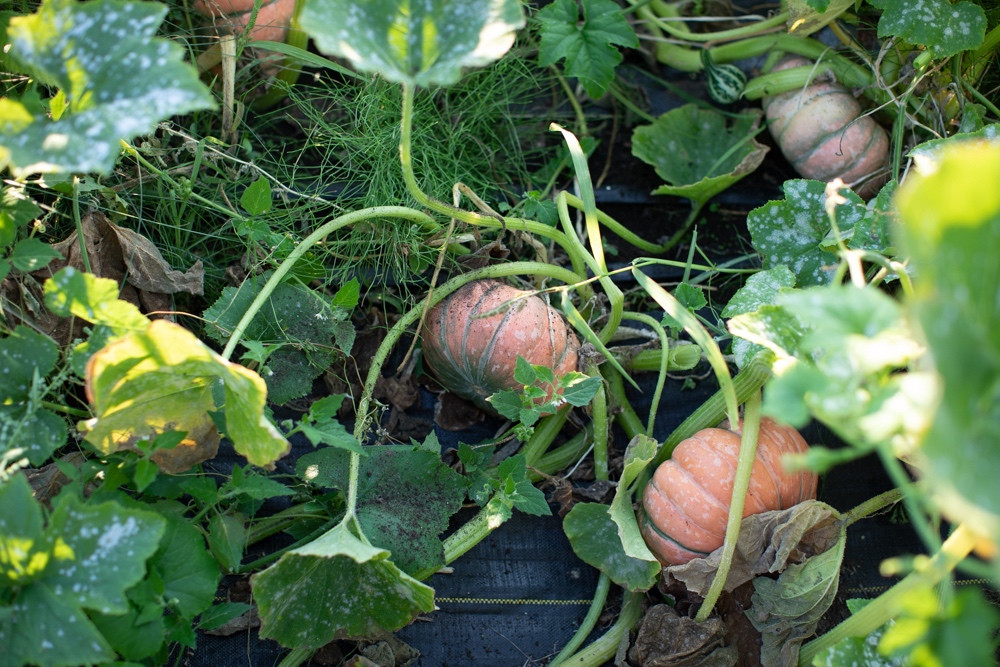 Harvest when the fruit is fully mature and the stem attaching it to the vine begins to turn brown. Cut the stems with a knife or pruning shears rather than pulling fruits off the vine. Stems should be cut to 3 to 4 inches (7 to 10 cm). If not used right away, cure for storage by setting in a warm, dry location for 1 to 2 weeks.
Harvest when the fruit is fully mature and the stem attaching it to the vine begins to turn brown. Cut the stems with a knife or pruning shears rather than pulling fruits off the vine. Stems should be cut to 3 to 4 inches (7 to 10 cm). If not used right away, cure for storage by setting in a warm, dry location for 1 to 2 weeks.
Here are some favorites.
 Few pumpkins can rival the beauty of ‘Rouge Vif D’Etampes’, a flaming, orange-red French variety. Also known as the Cinderella pumpkin, this gem looks like the pumpkin her fairy godmother transformed into her carriage. Though almost exclusively used as a decoration, this variety has a mild flavor and can be used for soup.
Few pumpkins can rival the beauty of ‘Rouge Vif D’Etampes’, a flaming, orange-red French variety. Also known as the Cinderella pumpkin, this gem looks like the pumpkin her fairy godmother transformed into her carriage. Though almost exclusively used as a decoration, this variety has a mild flavor and can be used for soup.
 ‘Long Island Cheese’ is a warm peach-toned pumpkin with a low, flat appearance resembling a wheel of cheese. Known for its sweet flavor, this variety makes an outstanding choice for pumpkin pies as well as other recipes, and it has good keeping quality.
‘Long Island Cheese’ is a warm peach-toned pumpkin with a low, flat appearance resembling a wheel of cheese. Known for its sweet flavor, this variety makes an outstanding choice for pumpkin pies as well as other recipes, and it has good keeping quality.
 ‘Zapalo Plomo’ produces an abundance of medium-sized, rounded, deeply lobed fruit that are glaucous-green with tan freckling and long tan stems. In addition to its beautiful coloring, it is delicious and extremely long-lasting.
‘Zapalo Plomo’ produces an abundance of medium-sized, rounded, deeply lobed fruit that are glaucous-green with tan freckling and long tan stems. In addition to its beautiful coloring, it is delicious and extremely long-lasting.
 One of the most unusual-looking varieties we’ve ever grown, ‘Galeux d’Eysines’ is a warm peach-colored squash covered in a thick layer of rough-textured light brown spots that resemble peanuts. People either hate it or love it. We’re in the latter camp. This French heirloom is also great for baking and soups.
One of the most unusual-looking varieties we’ve ever grown, ‘Galeux d’Eysines’ is a warm peach-colored squash covered in a thick layer of rough-textured light brown spots that resemble peanuts. People either hate it or love it. We’re in the latter camp. This French heirloom is also great for baking and soups.
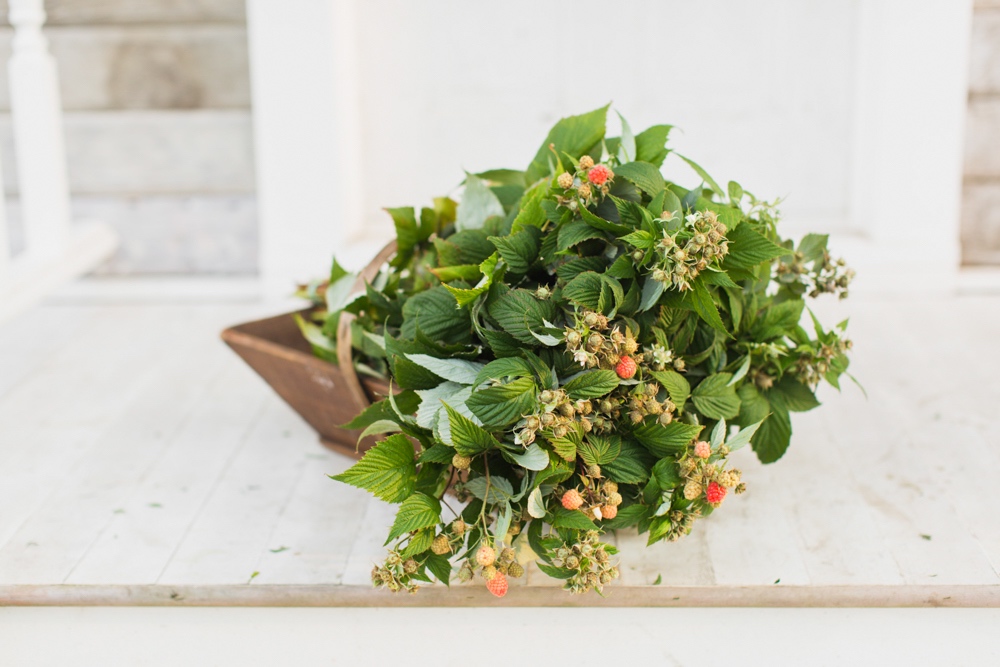 Raspberries
Raspberries
Raspberries are so versatile. I started using raspberry foliage in bouquets years ago, and it’s still on my favorites list. The plants are wildly productive, providing foliage all summer long.
The summer-fruiting types such as ‘Tulameen’ offer beautiful fruited branches for 3 to 4 weeks of abundant foliage from late spring through autumn. The greens last over 2 weeks in the vase.
The everbearing varieties like ‘Summit’ and the golden varieties are best for an extended harvest of fruiting stems, can be cut to the ground in the winter for easy clean-up, spread rapidly for increased stock, and grow in poorer soil than traditional summer-fruiting types.

Do you enjoy growing vegetables and edible flowers you can use in arrangements? Are there other varieties you’d like to try? I’d love to hear about your plans in your comments below.
Please note: If you submit a comment and it doesn’t show up right away, sit tight; we have a spam filter that requires we approve most comments before they are published.






Anna Maria on
Anna Maria,
io per una composizione estiva ho abbinato ai fiori i nostri dolcissimi fichi, frutti nel nostro territorio( Salento Italia) di abbondanza. Effetto sorprendente